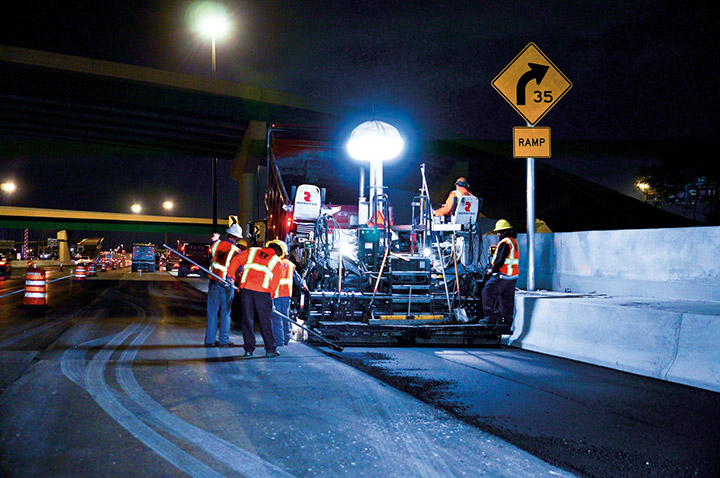Transform Your Residential or commercial property's Landscape with Hot Mix Asphalt Paving Excellence
Opening the Keys of Warm Mix Asphalt Modern Technology
Exploring the depths of hot mix asphalt innovation discovers a globe where exact solutions and careful procedures merge to form our roads and framework. The combination of aggregates, fillers, and binders isn't simply a building task but a tactical orchestration of sturdiness and effectiveness. As we peer into the intricate dancing of components, a tapestry of resilience and sustainability unravels. Yet what lies below this surface of asphaltic proficiency, and what tricks wait to be revealed in the realm of paving technologies?
Significance of Warm Mix Asphalt
Warm Mix Asphalt plays a crucial role in contemporary facilities advancement due to its longevity and cost-effectiveness. As the most commonly used leading product for roadways, freeways, and parking lots, Hot Mix Asphalt offers a range of benefits that contribute to its importance in building jobs.
The toughness of Hot Mix Asphalt stems from its make-up, which includes aggregates, binder, and filler products that are meticulously chosen and mixed to fulfill particular efficiency demands. Overall, the relevance of Hot Mix Asphalt in framework advancement can not be downplayed, as it proceeds to be a foundation of modern building practices.
Parts of Asphalt Mixes
The composition of asphalt blends consists of carefully chosen aggregates, binder, and filler materials that are crucial for accomplishing specific performance needs. Aggregates are the main part of asphalt mixes, providing stamina and security. These aggregates can be natural, such as gravel or smashed rock, or artificial, like recycled materials from old sidewalks. The binder, generally asphalt or asphalt concrete, holds the aggregates together and supplies adaptability and toughness to the mix. The option of the binder is essential as it straight influences the mix's performance in different weather. Fillers, such as hydrated lime or Portland concrete, are made use of to boost the mix's workability and aging resistance. Angled Parking.
The combination and percentage of these components play a significant role in determining the quality and performance of the asphalt mix. Engineers thoroughly develop the mix to satisfy particular demands, thinking about aspects like web traffic volume, climate conditions, and sidewalk lifespan. Correct option and harmonizing of accumulations, binder, and fillers are vital for producing resilient, lasting asphalt pavements.
Combining and Manufacturing Strategies

Once the aggregates are selected, the binder, frequently asphalt cement, is included in bind the materials together. The binder's top quality and quantity substantially affect the mix's versatility, resistance, and toughness to ecological aspects. Furthermore, fillers like hydrated lime or Portland concrete may be integrated to enhance specific characteristics of the asphalt mix, such as its workability or dampness resistance.
Throughout production, the aggregates and binder are warmed, typically in between 250-325 ° F(121-163 ° C ), to assist in blending and guarantee proper coating of the accumulations. The blending process has to be detailed to accomplish a homogeneous mixture that advertises the wanted efficiency attributes of the asphalt. Various strategies, such as batch mixing or drum wikipedia reference blending, are employed to attain high-grade and consistent asphalt blends for construction tasks.
Aspects Affecting Asphalt Efficiency
Elements affecting asphalt efficiency encompass a variety of variables that influence the sturdiness, long life, and overall high quality of asphalt sidewalks. One vital factor is the quality of materials utilized in the asphalt mix.

Environmental problems also affect asphalt performance. Temperature level variants, wetness seepage, and traffic tons can all influence the structural honesty of the pavement. Style factors to consider, such as pavement density and drainage, are necessary in guaranteeing the lasting performance of the asphalt pavement. By official statement very carefully considering these elements, designers and contractors can maximize asphalt efficiency and enhance the life span of pavements.
Lasting Practices in Asphalt Modern Technology

Additionally, the development of warm-mix asphalt (WMA) modern technologies has actually gotten traction recently. WMA permits the manufacturing and positioning of asphalt mixes at reduced temperatures contrasted to typical hot-mix asphalt, causing minimized energy intake and greenhouse gas discharges. Additionally, the use of permeable asphalt mixes can aid alleviate stormwater runoff concerns by enabling water to infiltrate via the sidewalk and into the ground, advertising natural water purification and charge processes. By carrying out these sustainable methods, the asphalt industry can add to constructing a much more eco-friendly and resistant facilities network.
Verdict
In final thought, warm mix asphalt innovation plays a crucial role in modern facilities look at this website advancement because of its longevity and cost-effectiveness. By thoroughly balancing elements, utilizing appropriate mixing methods, and thinking about various factors, engineers can develop high-quality asphalt mixes that withstand hefty website traffic lots and rough weather. Welcoming lasting methods, such as using warm-mix modern technologies and recycled products, additionally improves the environmental kindness of asphalt innovation.
Blending and manufacturing strategies in hot mix asphalt technology involve the specific combination and processing of accumulations, binder, and fillers to produce a resilient and high-performance asphalt mix.Variables influencing asphalt performance incorporate a range of variables that influence the toughness, durability, and overall top quality of asphalt pavements. Lasting methods in asphalt technology incorporate various campaigns aimed at reducing the ecological impact of asphalt manufacturing and paving processes. By integrating reclaimed asphalt sidewalk (RAP) and recycled asphalt shingles (RAS) right into new asphalt blends, the industry can substantially reduce the intake of raw materials and power, while additionally reducing land fill waste.
WMA allows for the manufacturing and placement of asphalt mixes at reduced temperature levels compared to typical hot-mix asphalt, resulting in decreased power consumption and greenhouse gas discharges.